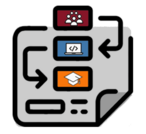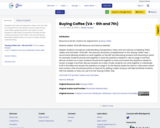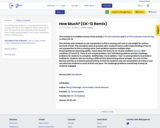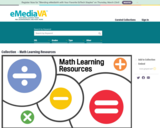
7.3 Algebra Readiness Formative Assessment
- Subject:
- Mathematics
- Material Type:
- Assessment
- Provider:
- VDOE
- Author:
- VDOE
- Date Added:
- 10/07/2024

7.3 Algebra Readiness Formative Assessment

Solve problems using computational procedures for percents, ratios, and proportions - Algebra Readiness Remediation Plan

Apply proportions to solve problems - Algebra Readiness Remediation Plan

Apply proportions to solve problems involving percentages - Algebra Readiness Remediation Plan

Use ratio tables and proportions to solve problems - Algebra Readiness Remediation Plan

Apply proportions to solve problems - Algebra Readiness Remediation Plan

Solve problems using ration tables and computational procedures for percents, ratios, and proportions - Algebra Readiness Remediation Plan

Using proportions to convert between and among measurement systems - Mathematics Instructional Plan

Solve Single and Multistep Practical Problems Using Proportional Reasoning Formative Assessment - Just in Time Quick Check, Teacher Notes, and Supporting Resources

Solving a proportion to find a missing term - Mathematics Instructional Plan

Using proportional reasoning to solve problems involving percents - Mathematics Instructional Plan

This Unit plan help teacher organize and navigate through 7,3 Tax Tip Discount portion of the Computation and Estimation section of Math 7 SOL standards.

The goal of this activity is to build critical thinking skills and excitement for Computer Science / Computational Thinking, while laying a foundation of fundamental programming concepts. By scaffolding basic concepts like sequencing and algorithms in an unplugged activity, students who are intimidated by computers can still build a foundation of understanding. In this lesson, students will learn how to develop an algorithm and encode it into a program.By "programming" one another to draw pictures, students experience some of the core concepts of programming in a fun and accessible way. The class will start by having students view a video of a simple program demonstrating how to develop instructions for building a peanut butter and jelly sandwich. Students will start with simple shapes, and progress to the coding of a specific drawing that other students will then try to replicate (“running the program”). If there is a desire to have a more of a Math slant on the lesson, the drawing could take place on graph paper. Students would then use the coordinates to complete the drawing.

Students lean about proportions, ratios, and unit rate. It is important for connections to be made among ratio tables, graphing points, and slope of a line. Students make these connections through the first activity provided by the VDOE. The second task by Illustrative Mathematics is a way to assess student understanding.

Using proportions to convert between and among measurement systems.Mathematics Instructional Plans (MIPs) help teachers align instruction with the 2016 Mathematics Standards of Learning (SOL) by providing examples of how the knowledge, skills and processes found in the SOL and curriculum framework can be presented to students in the classroom.

In this lesson, students will be introduced to the idea of decomposition. Specifically the lesson caters to math word problems, but could be easily modified to any subject (as found in the modificaitons section of the lesson plan). Students will engage with each other and the vocab to work through an easy process to decompose word problems into manaeagable pieces as a strategy to solve. All activities are low prep and can be modified to your needs. This can be a stand alone lesson or expanded by using Part 2 and Part 3 to deepen understanding through coding activities.

This lesson expands upon the ideas of decomposition by using GameChangineer to incorporate commands to create a coded mini game from decomposing word problems. Students will assist the teacher in this guided lesson on how to create commands and use the website before engaing independently in Part 3. Activities are low prep with modifications included, but do require organized planning to implement effectively. If you have not done a lesson on decomposition, it is suggested you use Part 1 to help student's gain the necessary understandings of the processes used in this lesson.

This is the final part of an extended lesson on decomposition. Students will create a word problem to decompose and then use GameChangineer to create a mini game that is reflective of the word problem and its solution. Students will be using the plan, design, and review process thourhgout their creations. A rubric and self reflection tool for the final products are included. Activities are low prep with modifications included, but do require organized planning to implement effectively. If you have not done a lesson on decomposition, it is suggested you use Part 1 to help student's gain the necessary understandings of the processes used in this lesson. If you have not done a lesson on writing commands and using GameChangineer, it is suggested you use Part 2 before implementing this independent activity.

This activity asks students to use proportions to find a missing unit cost or unit weight for various amounts of fruit. This should be used as practice after students have a solid understanding of how to use a proportion to find a missing value.

Students will find helpful resources for learning and practicing math skills and processes in this eMediaVA collection.